Alfresco
Documents server Alfresco
- Prerequisites
- Digdash user / Alfresco user
- Create a new Alfresco document server
- Server Configuration
- Access rights (limited)
- Available actions
Prerequisites
- An Alfresco server (development and tests have been realized on the Community version of Alfresco (free version))
- Alfresco’s administrator’s identifiers (for the server configuration)
- Knowing the Alfresco structure (for the server configuration)
- Creating one or more Alfresco users with the same usernames defined in Digdash
Digdash user / Alfresco user
In this document, we suppose that the current Digdash user also exists in Alfresco with the same username.
Create a new Alfresco document server
Digdash Enterprise allows you to get your documents on your Alfresco account.
- Via the Digdash Studio
To create a new Alfresco document server in the Digdash Studio :
Open the Enterprise Studio of Digdash > Tools > Server URL manager… > New...


Screenshot: Creation of a new Alfresco document server
- Via the browser
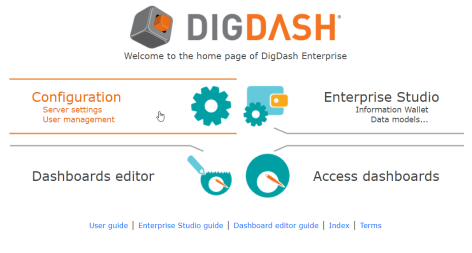
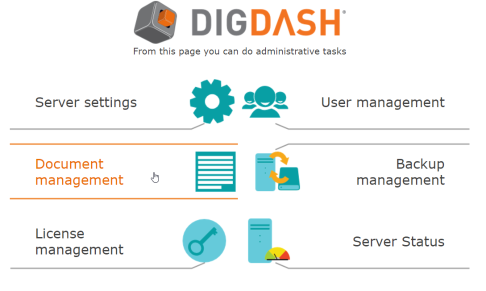
Screenshot : the document manager via the browser
Server Configuration
- Via the Digdash Studio
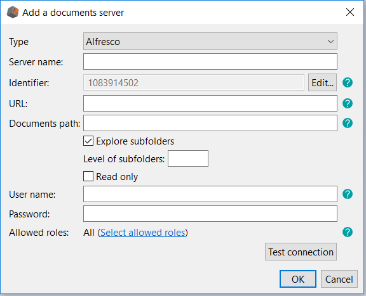
Screenshot: Server configuration for Alfresco via the Studio
- Via the browser
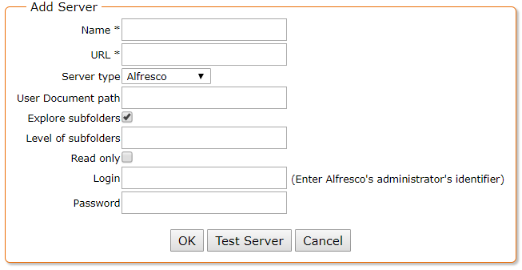
Screenshot: Server configuration for Alfresco via the browser
Identifiers (login / password)
The current Digdash user (whoever they are) will always be logged as the Alfresco admin.
URL
The user has to specify the Alfresco server’s address and the port number if necessary.
Path (documents path for a user)
The path the user has to specify to commit the actions mentioned below has the following pattern:
Site/Container/Uploaddirectory
Site and Container are mandatory
Uploaddirectory is optional
| Site/ | Container/ | Uploaddirectory |
| Site name | A container is a folder or space in a site (« Document Library » most of the time) http://docs.alfresco.com/5.1/concepts/library-intro.html | Name of the folder where the document will be uploaded. This folder must already exist. |
Table: Alfresco’s path pattern for the configuration server
Example:
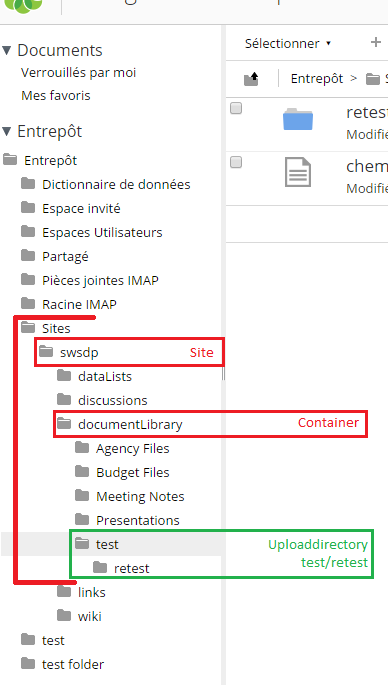
Screen: Example of an Alfresco tree for a site (called « swsdp »)
Here is a given path: swsdp/documentLibrary/test/retest
| Site/ | Container/ | Uploaddirectory |
| Site name | A container is a folder or space in a site (« Document Library » most of the time) http://docs.alfresco.com/5.1/concepts/library-intro.html | Name of the folder where the document will be uploaded. This folder must already exist. |
| swsdp/ | documentLibrary/ | test/retest |
Table: Example: path for a site on Alfresco
Exploration of subfolders
You have the possibility to set the level of exploration of the subfolders from your document path.
By default, Digdash seeks for all your documents, recursively, and explores all the subfolders.
| Fields | Explore subfolders | Level of subfolders | |
| Values | Selected | Empty Default value, exploration in all subfolders | N > 0 Exploration in the N subfolders |
| Deselected | 0 No exploration in the subfolders, only in the current directory | ||
Table for the different levels of exploration of subfolders
Access rights (limited)
Despite the fact that the current Digdash user is logged as Admin on Alfresco, we have decided to limit the access rights for the user (other than Admin) to a certain point according to Alfresco’s restrictions.

Table: Roles and permissions for the documents, Alfresco wise
Thus, a Consumer (uninvited user on the site) only has the rights of reading and downloading documents.
We have deliberately chosen not to limit the rights (Alfresco wise) for the actions that would only be possible when the current Digdash user is the creator (oranges cells).
Available actions
*According to the access rights and the directory mentioned in the server configuration.
Search by keywords

Screen: Search bar for the documents on Alfresco
The current Digdash user will be able to search for documents in the directory mentioned in the configuration AND in the subdirectories entering keywords in the search bar.
If the search bar is empty, then « * » is applied (all the documents in the directory AND subdirectories will be displayed).
Downloading a document from Alfresco
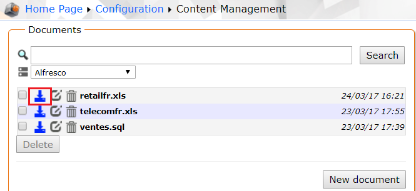
Screen: downloading a document from Alfresco
It is a basic action. Every connected Digdash user is at least able to read any documents on any Alfresco sites, and particularly the site specified during the server configuration.
This action is possible via this icon: .
.
Uploading a document on the Alfresco server
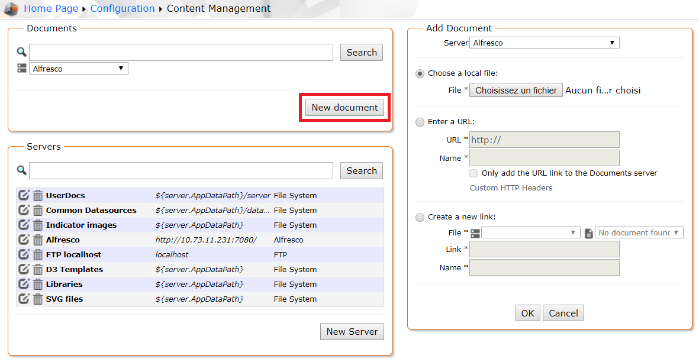
Screen: Uploading a document on Alfresco
Depending on the current user’s role in Alfresco, they have the have the right to upload documents in the directory specified during the server configuration.
(Cf. table: title)
Three options are possible:
- Choose a local file: click on Browse... to select the document to add. Click OK. The dialog Open shows.
- Enter a URL: Enter the URL of your document. If the checkbox Only add the URL link to the Documents server is deselected, the content pointed by the URL is downloaded only just once. If the checkbox Only add the URL link to the Documents server is selected, the content will be downloaded by the server every time it needs to (for a data source or required by the user). If required by the user, the URL must be reachable by the server. You can also insert user variables in the URL (${user.uid}, etc. Cf documentation). You can use a URL starting with « file:// » but in that case, the option Only add the URL link to the Documents server is selected by default. This kind of URL should refer to a file on the disk of the server. The link name must end with the extension of the file (.csv, .html, etc.).
- Create a new link: Create a new link to a document on the server. The pointed file is the last document (alphabetically) corresponding to the link. For example, a link like “document*.csv” will refer to the last CSV file starting with “document”.
 To go further: (v1 of this functionality)
To go further: (v1 of this functionality)
The fields called « Author » and « Creator » of the document are updated with the current Digdash username once the document is uploaded.
If the user does not have the right for this action, a message will notify the action could not take place.
Updating a document on Alfresco

Screen: updating a document on Alfresco (renaming and updating content)
This action is possible via this icon: .
.
Depending on the current user’s role on Alfresco, they have the have the right to modify the documents they have the right to edit (c.f. table). Here are the possible actions:
Updating the document content
The user with the adequate access rights is able to update the content of an existing document selecting another file on their file system.
 This unique action will not alter the document name.
This unique action will not alter the document name.
If the user does not have the right for this action, a message will notify the action could not take place.
Renaming
The user with the adequate rights is able to rename a document. They will specify in the text field the new name without any extension (it remains the same).
If the user does not have the right for this action, a message will notify the action could not take place.
Deleting a document on Alfresco
The user with the adequate rights is able to delete one or several existing documents in the directory specified during the server configuration.
If the user wants to delete more than one document, they can do it thanks to the check boxes.
This action is possible via this icon:  .
.
If the user does not have the right for this action, a message will notify the action could not take place.